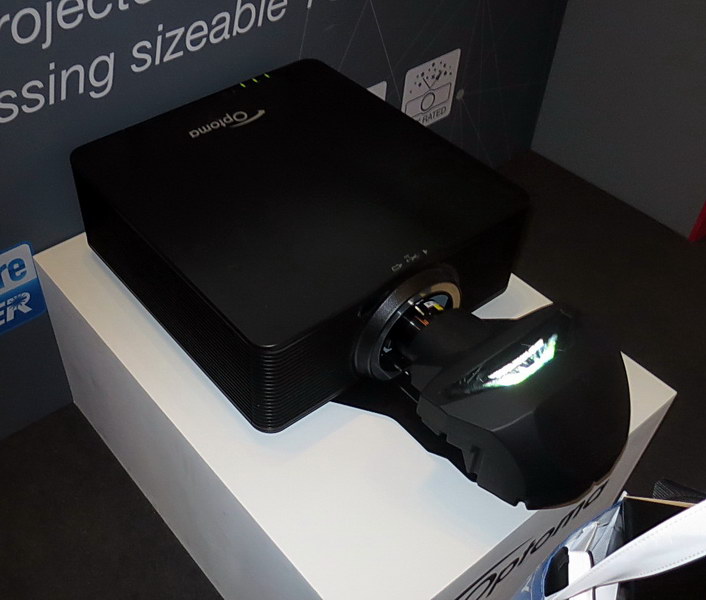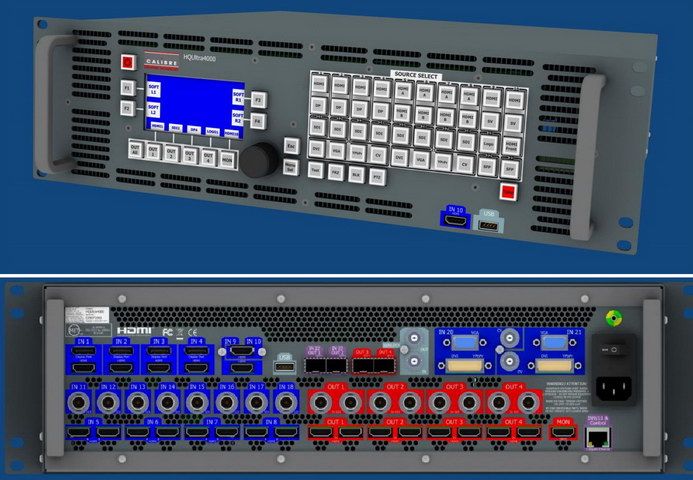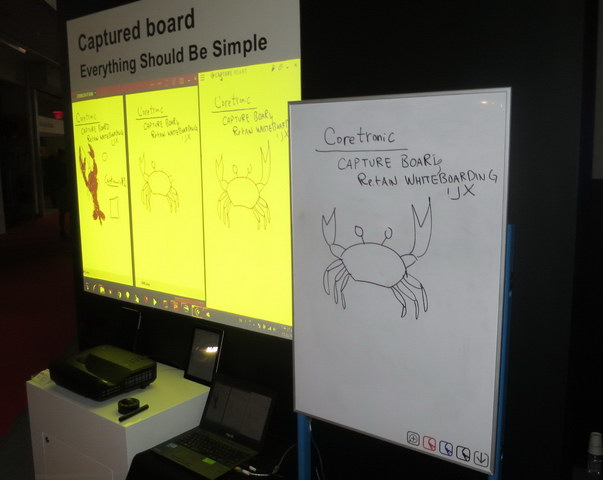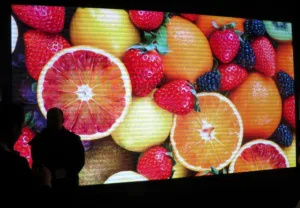Coretronic and its subsidiary Optoma had separate but adjacent booths at ISE. Calibre, the UK-based manufacturer of video scaler, switcher, processor and control systems had been acquired by Coretronic last August and was exhibiting in the Coretronic booth (Coretronic Acquires Calibre). At ISE 2018, a Calibre representative explained to me that Coretronic expects to maintain the Calibre brand name and research and development facilities in the UK. Manufacturing will also continue in the UK for the time being. He said that much of the motivation at Coretronic to acquire Calibre was to acquire the scaling and switching technology that is very necessary for the design and manufacturing of LED video walls.
“It reflects Coretronic’s strategy to strengthen its leading position in display and image processing technology with a rich set of capabilities afforded by the Calibre team. This will help Coretronic Group with its plans to further advance in the pro AV markets as well as assisting with entry into the rapidly expanding direct-view LED display markets,” enthused SY Chen, President of Coretronic, in the 16 August 2017 Calibre press release announcing the acquisition.
The Optoma model FHD26528 LED videowall on display in the booth at ISE. The artifacts in the image were not visible to the eye. (Credit: M. Brennesholtz)
The first fruit of Coretronic’s move into the direct-view LED display market was introduced and on display at ISE 2018: an Optoma-branded LED display. The displays are intended for permanent indoor installation and are not for the rental and staging market. All units are 56mm thick when mounted on the wall. First the frames are screwed to the wall and then the display is made flat using built-in adjustment screws. After leveling, the electronics and then the LED display panels are installed. All work is done from the front and there is no need to pierce the wall for cables.
Initially, four screen sizes will be available although Optoma says custom sizes will also be available. Details of these models are shown in the table.
|
Model Name |
FHD18020 |
FHD22626 |
UHD36120 |
UHD45226 |
|
Screen Size (diagonal inches) |
180” |
226” |
361” |
452” |
|
Screen size (W x H, Meters) |
4 x 2.2 |
5 x 2.8 |
8 x 4.5 |
10 x 5.625 |
|
Minimum Viewing distance (M) |
2.0 |
2.6 |
2.0 |
2.6 |
|
Pixel Pitch (mm) |
2.0 |
2.6 |
2.0 |
2.6 |
|
Brightness (Nits) |
1000 |
1000 |
1000 |
1000 |
|
Note: the pixel pitch is not specified by the Optoma documentation but was given to me by the Optoma rep at ISE. |
||||
The Optoma videowalls with the 2.6mm pitch are shipping now and the walls with the 2.0mm pitch are expected to ship later this year. The wall is shipped as a system ready for installation, including the modules, the display sender and a dedicated, Optoma-branded controller, scaler and switcher with seven inputs. The display sender communicates with the display via Cat 5 cable. If a customer needs more than seven inputs, a Calibre switcher can be substituted. The price of the unit as demonstrated at ISE was about €90K, including the FHD22626 LED video wall, the 1080p MCTRL660 display sender and the Optoma LS200T switcher.
Optoma was showing several other new products at ISE. One was the BX-CTADome projection lens that allowed a single projector to fill a dome from one side. Unlike most other dome projection lenses, this did not require the projector to be in the center of the dome. The lens was said to be good for domes with diameters of 3M to 10M. The lens is compatible with Optoma ZU650+, ZU850 and ZU1050 DuraCore DLP laser projectors. The system was demonstrated with a ZU850 WUXGA (1920 x 1200) single-chip laser projector with both red and blue lasers. (a similar concept was demonstrated by Panasonic Panasonic Shows New Projectors, LCDs at ISE)
 Optoma’s new BX-CTA16 lens shown installed on a ZU850 projector. (Credit: M. Brennesholtz)
Optoma’s new BX-CTA16 lens shown installed on a ZU850 projector. (Credit: M. Brennesholtz)
Optoma also unveiled its BX-CTA16 ultra short throw lens with a throw ratio of 0.36:1. This lens is also compatible with the single-chip DuraCore laser projectors (ZU650+, ZU850 and ZU1050).
The recently introduced ZU1050 flagship DuraCore laser projector was scheduled to be shown at ISE in a four-projector blended installation but I must have missed it if it was there. The only four-projector blend I saw at the Optoma booth used UHZ65 4K UHD laser projectors which were introduced last year. The ZU1050 is a single chip DLP WUXGA projector with 20,000 lumens output. It features MCL technology (Multi Colour Laser) with red and blue lasers and green light from phosphor-conversion. It is part of the DuraCore projector range which combines longer-lifetime light source and an independent IP-rated dust certification.
Calibre Shows Switchers & Scalers
 Front and rear of the new Calibre HQU4030 scaler/switcher. (Credit: Calibre)
Front and rear of the new Calibre HQU4030 scaler/switcher. (Credit: Calibre)
Calibre was showing its new HQUltra4030 scaler/switcher. This unit has 30 inputs and 4 4K/UHD outputs. The HQUltra4030 is said to be
“the perfect solution for connecting to the new extremely large LED and flat panel videowalls. The scaled image can be distributed across all four outputs, perfectly aligned and synchronized, allowing the HQUltra4000 to drive a programme surface area up to true 8K/Quad-UHD. That is an incredible 8192×4340 pixel area.”
The new features added to the HQUltra4030 compared to the existing HQUltra4000 are support for multiple layers with up to seven PIPs/layers in total, plus a scalable background layer for each output channel. It is said to be ideal for control room, broadcast and events environments. The HQUltra4030 is expected to be released in August, 2018.
Coretronic Highlights Touch
 42” Coretronic Capture Board coupled to a short-throw projector. (The yellow color in the projected image is an artifact of photographing a single panel DLP projector.) (Credit: M. Brennesholtz
42” Coretronic Capture Board coupled to a short-throw projector. (The yellow color in the projected image is an artifact of photographing a single panel DLP projector.) (Credit: M. Brennesholtz
Coretronic was showing a 42” whiteboard with a built in capacitive touch whiteboard (not a display) that responds either to special pens or a finger. The unit was connected to a short-throw projector in a collaborative system. The 42” version of the system is expected to ship in Q2. A 46” version is expected to ship in Q3 and an 85” version should ship in Q4.
 Curved capacitive touch screen in the Coretronic booth. (Credit: M. Brenneshotlz)
Curved capacitive touch screen in the Coretronic booth. (Credit: M. Brenneshotlz)
In the Coretronic booth, perhaps the most interesting demo was another example of Coretronic capacitive touch technology. It was a large, 5M long, curved, 30-point capacitive touch screen lit by three projectors edge-blended on the curved screen. This is similar to last year’s display of an even larger (7M long) but flat touch screen system lit up by four edge blended projectors. That system used touch built into the individual projectors, not capacitive touch. The curved unit shown at ISE was a prototype demonstration unit, not a product, and a ship date has not been set. The Coretronic rep said Coretronic could make larger curved capacitive touch screens up to 7M long but shipping a screen this large was, in fact, an issue.
Another prototype product being shown was ultra-short throw 4K projector with a 0.18 throw ratio and 5K lumens output. This projector was said to be about one year from shipping.
Lamps Remain an Option at Coretronic
I was also told that all future Coretronic or Optoma projectors over 5K lumens would be laser projectors, along with some of the projectors under 5K lumens. The company feels, however, that there is still a valid market for lamp-based projectors with output under 5K lumens.
One of the key advantages of laser projectors is longer life. Another advantage, especially in DuraCore laser projectors with both red and blue lasers, is better colorimetry than lamps. However, many applications of low-brightness (under 5K lumens) projectors don’t need either the long life or the improved colorimetry that comes with lasers. For this reason, Coretronic expects to continue to develop and improve lamp-based projector technology. –Matthew Brennesholtz

